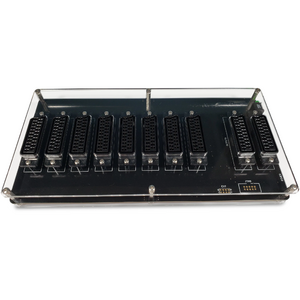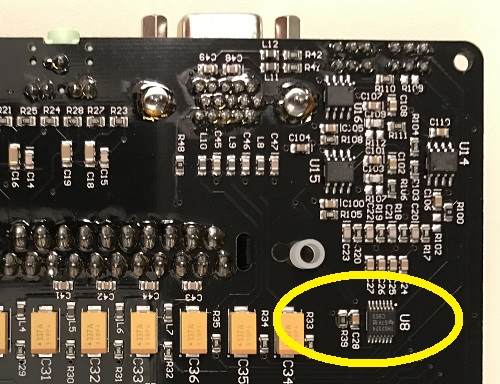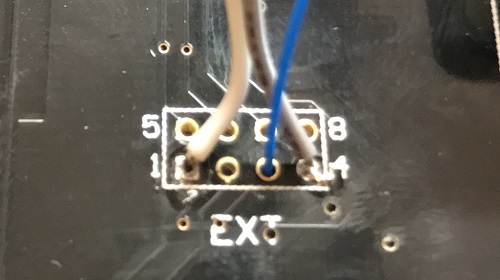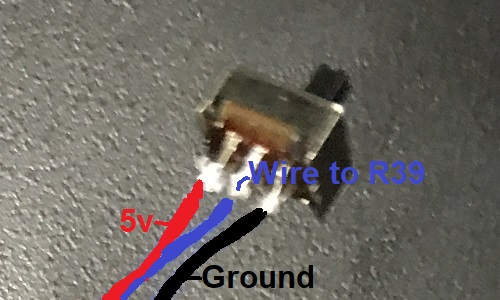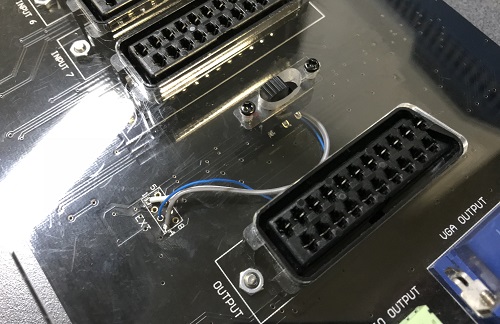AV:Gscartsw: Difference between revisions
No edit summary |
No edit summary |
||
| Line 48: | Line 48: | ||
[[File:gscartsw_lpf-04.jpg]] | [[File:gscartsw_lpf-04.jpg]] | ||
Then solder the three wires to a 2-position, 3-pole switch. Make sure that the wire coming from the pad & resistor is in the middle position. The orientation of the other two don't matter, but note that Ground = LPF On and 5v = LPF Off. | |||
[[File:gscartsw_lpf-05.jpg]] | [[File:gscartsw_lpf-05.jpg]] | ||
Revision as of 04:16, 13 June 2022
This is an 8-port dual-output SCART switch made specifically for retro-gaming. Both output ports can be connected at the same time, and it features automatic switching between consoles.
Purchase yours here.
All questions and support should be posted in the forum
Features
- Bundled with power supply
- 8 SCART inputs
- 2 SCART outputs (simultaneous output supported)
- Automatic switching (via signal detection)
- Integrated sync stripper with sync regeneration and RGsB support
- Integrated DC Restore circuit
- PSU polarity protection included.
- Switch dimensions: 10-1/2 x 5-1/8 x 1-1/2 - Weight: 1lb, 5oz
Other Info
The gscartsw will automatically detect which console is powered on and switch to it. It's best to not power on more then one console at a time, but doing so will not damage the switch. Also, you can chain two gscartsw's together for 15 total inputs:
LPF Toggle Mod
This is for the gscartsw only, _not_ the 'lite', as the lite doesn't use a chip with a filter. This mod toggles the low-pass filter on the THS7374 amp that's inside the gscartsw. When going from analog to digital, you'll always want one LPF in your chain, or you can get interference on the screen. The only "problem" with LPF's is when more then one are in the same chain. The end effect results in a slightly blurred image.
LPF On:
- Framemeister
- Direct into a flat-screen
- Direct into a capture card
LPF Off:
- OSSC (use its LPF instead)
- RGB Monitors
- Any time another device already has one built in (including in the above scenarios), such as a console with a THS7314 mod.
Instructions
Start by unscrewing everything. Be sure to _ave every single spacer and screw. Then flip it over and look for this spot (notice the VGA port on the top for orientation)
Next, carefully desolder and move the "R39" resistor over, as this is the spot on the board that goes directly to the LPF toggle pin. You'll want to move it over, so it's covering the "R39" lettering and make sure the pads aren't connected at all. Then solder a wire to the other side of the resistor. It's best to tack the wire down with a tiny bit of glue, so that the wire isn't flopping around. Then run it through the unused pin 3 of the EXT port out to the top. DO NOT SOLDER THE WIRE TO PIN 3, just use it as a way to route the wire through to the top of the board.
Next solder wires to pin 1 (ground) and pin 4 (5v) on the Ext port:
Then solder the three wires to a 2-position, 3-pole switch. Make sure that the wire coming from the pad & resistor is in the middle position. The orientation of the other two don't matter, but note that Ground = LPF On and 5v = LPF Off.
Switch mounting and reassembly
Note: Drilling through thick acrylic is a pain. An alternative would be to epoxy/CA glue the switch to the case.
Results
Bob from RetroRGB found that there's still a small amount of filtering happening, even with the LPF turned off.
